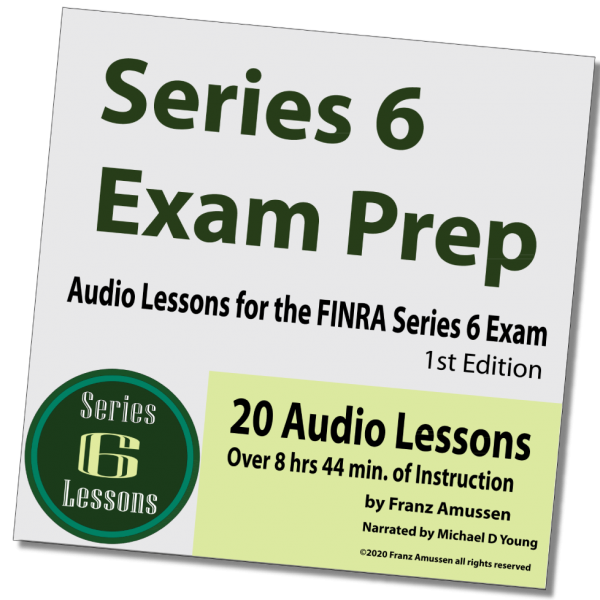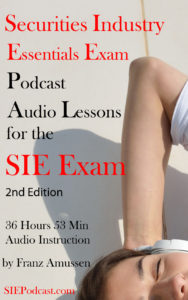Series 6 Lesson 4 is about Investment Vehicles
Series 6 Lesson 4 Investment Vehicles Lesson discusses
This are different ways you can suggest people invest their money. Each carries a different level of risk vs. reward.
Series 6 Lesson 4 covers Equity Investments: The investor buys equity in a company, which means they own a certain percentage of the company and are given that percentage of the profits. This is a high-risk security, because if the company does not do well, the person will not make much money.
Common Stock: The investor buys shares of a company. They can make money if their shares appreciate in value or if they are paid dividends when the company is doing well. Different stocks carry different amounts of risk. Many stocks can be quite volatile. The investor has limited liability that is only equal to the number of shares you own. If the company goes bankrupt, the creditors cannot came after the stockholders. Shareholders can transfer their shares to others, both by selling them or by giving them away. Companies have transfer agents, who oversee the transfer of shares and who can reissue your stock certificates if you lose them in return for a fee. A registrar, another financial institution, makes sure all the numbers are adding up correctly. Shareholders have the right to inspect the books/records of the company.
Stock can also pay dividends if the Board of Directors for a company declares them. This usually happens if things are going well for the company. The more stock you own, the greater the dividends are going to be.
Stock owners also have what is called a pre-emptive right. This means if new shares of stock are going open to the public, the existing stock holders have the right to purchase their proportion of the new shares before others get to buy them. This means that they get the chance to maintain the percentage of the company that they own so that their own shares are not “watered down”. You can enjoy a subscription right as a stock holder, which allows you to buy new stock below the regular market price for the period of a few weeks.
Another stock term is a warrant, which a certificate that lets you buy a specific stock at a certain guarded price. You can wait for the stock to become much more valuable and then purchase that stock at the best price to make a lot of money.
American Depository Receipt: (ADR) This is a receipt given to someone against shares of foreign stock that is simply held in a bank. You can invest in foreign companies but instead buy through an ADR, which trades on the American system so that you don’t have worry about exchange rates when actually purchasing the shares and time differences in distant European or Asian markets. You have to worry about currency exchange risk, which means that when you are collecting dividends, those are still issued in the foreign currency, Euros or Yen, or whatever else, and if the exchange rate is not favorable to the dollar, you may end up losing out.
Preferred Stock: This kind of stock pays a fixed income stream, but its actually still an equity position. Unlike regular stock, it does not rise in value when a company’s profits increase. It does not have the same risk as common stock, but it also does not have the same potential rewards that common stock can offer. It is called preferred stock, because these shares are given preferred treatment if the company has to be liquidated. The preferred shareholders get their dividends all paid out before any of the common stock holders get any of their money. Unlike common stock, it has its rate of return printed right on it (3% or 5%, etc.) This is a percentage of the par value of the stock. If that were $1,000, a 3% stock would pay $30 per share per year.
Measuring Yield
There are two things you need to take into consideration: growth (capital appreciation) and income (dividends). Growth means that your shares grow in value. If you buy your shares at $8/share and then sell them for $11/share, you have made money through capital appreciation. If you pay $10 for a share of stock and you get a $3 dividend on that share, that means you have made a 30% dividends. If you add the two together, you get what is known as the total return.
Dividends are paid quarterly, which means four times per year. If you want to calculate the annual dividend on something, you need to multiply it by four. ($3 x 4 = $12)
Options
These are contracts between two parties that let the owner buy a certain number of shares of stock at a certain price or sell a certain number of shares of stock for a set price. The option to buy stock is known as “calls” and the option to sell stock is known as “puts”.
We also offer a Professional Bundle of lessons for the Serious Financial Professional
Podcast: Play in new window | Download (Duration: 10:52 — 4.5MB)
Subscribe: Apple Podcasts | RSS | Subscribe to Podcast




